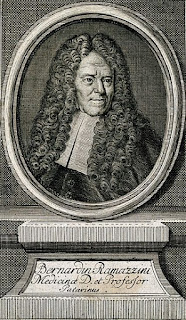Pioneer in knowledge of occupational diseases, cancer and malaria
 |
| Ramazzini worked in medicine for more than half a century |
Ramazzini’s tour de force, which he completed at the age of 67, was his book De Morbis Artificum Diatriba - Discourse of the Diseases of Workers - which came to be regarded as a seminal work in his field, the lessons from which still influence practice today in the prevention and treatment of occupational diseases.
A student at the University of Parma, Ramazzini was appointed chair of theory of medicine at the University of Modena in 1682 and professor of medicine at the University of Padua from 1700 until his death in 1714.
It was while he was in Parma that he began to take an interest in diseases suffered by workers.
When he became a departmental head at Modena, he began to study the health problems of workers in a more systematic way. He would visit their workplaces, observe the activities they undertook in their work and discuss their health problems with them.
Ramazzini could see that some diseases were attributable to the materials they worked with, including chemicals that would now be classified as hazardous, or the dangers posed by equipment.
 |
| The first page of the 1713 edition of Ramazzini's work on the study of occupational diseases |
Ramazzini saw a relationship between certain disorders and the repetition of particular motions, or the lifting of heavy objects, but also noted that certain diseases appeared to be prevalent in workers whose environment restricted the amount of movement, such as sitting for long periods.
This research formed the basis of many of his lectures and he recommended to doctors treating sick patients that their diagnostic questions should include asking about the patient’s place of work.
Ultimately Ramazzini was able to group his findings in to four areas: occupations that require workers to handle minerals and metals or other raw materials extracted from the earth; workers exposed to air-borne toxins; workers exposed to fluids such as water, milk and alcoholic beverages; and workers whose jobs involved unnatural postures or positions held for long periods.
 |
| Ramazzini made important observations about cancer and malaria |
Ramazzini took 10 years to bring together all his observations in De Morbis Artificum Diatriba, which carried the authority of more than 40 years in medical practice. He urged physicians to promote the thinking that prevention was as important in cure.
Away from occupational health, Ramazzini was one of the first to point science towards the role that hormones might play in the development of some cancers. This was based on his observations that there was a virtual absence of cervical cancer among nuns, but a high incidence of breast cancer, which he postulated as possibly due to their abstinence from sexual activity.
He was also one of the first to support the use of quinine - found in the bark of the cinchona tree - as a treatment for malaria.
Ramazzini died in Padua in November, 1714.
| The Castello del Pio on Piazza Martiri in Carpi, one of the largest public squares in Italy |
Carpi, where Ramazzini was born, is situated about 18km (11 miles) north of Modena in the Padana plain. It became a wealthy town during the era of industrial development in Italy as a centre for textiles and mechanical engineering. Its historic centre, which features a town hall housed in a former castle, is based around the Renaissance square, the Piazza Martiri, the third largest square in Italy. Italy’s national marathon has finished in Carpi in 1988 in honour of another of the town’s famous sons, the marathon runner Dorando Pietri.
 |
| The Duomo and Palazzo Communale in Piazza Grande in the heart of Modena |
Modena, where Ramazzini spent part of his academic life, is a city on the south side of the Po Valley. It is known for its car industry, as Ferrari, De Tomaso, Lamborghini, Pagani and Maserati have all been located there. The city is also well known for producing balsamic vinegar. Operatic tenor Luciano Pavarotti and soprano Mirella Freni were both born in Modena. One of the main sights in Modena is the huge, baroque Ducal Palace, which was begun by Francesco I on the site of a former castle in 1635. His architect, Luigi Bartolomeo Avanzini, created a home for him that few European princes could match at the time. The palace is now home to the Italian national military academy.
Also on this day:
1657: The birth of Neapolitan painter Francesco Solimena
1720: The birth of print maker and architect Giovanni Battista Piranesi
The Feast of Saint Francis of Assisi
Home



